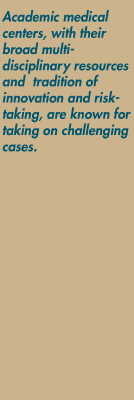With her bright eyes, disarming smile and impish humor, it’s easy to picture Lasheka Stubbs bouncing
down the halls of Sacramento’s Foothills Junior High School, giggling with her girlfriends. "I’ll
be back in school next week," she vows from her room at UC
Davis Medical Center, as grandmotherCarol Taylor laughs and rolls her eyes. "She keeps telling
people that," Taylor says, turning to smile at her granddaughter. "Maybe not next week, Lasheka,
but soon."
Lasheka, 13, is in the seventh grade this year, but has yet to spend much time inside her middle school. Because of her severe health problems, her teachers came to her house for a portion of sixth grade and through the first half of seventh. Now, thanks to a series of aggressive surgeries that some of the nation’s top specialists said couldn’t be done, Lasheka should be back in the classroom within the month — If not next week.
Lasheka was diagnosed at age 7 with a desmoid tumor in her ankle. That growth was surgically removed when she was 8. But over the next several years a new mass occurred in her thigh, grew up into her groin, and eventually ballooned into a solid, beach ball-sized growth that took over her entire pelvis and abdomen and ate through her lower abdominal wall. "People said I looked nine months’ pregnant," recalls Lasheka, whose digestive system all but shut down as the 15-pound mass crowded out her stomach and other organs.
"It was really taking a toll on her whole body," says Taylor, who is Lasheka’s primary caregiver. "She couldn’t eat, couldn’t keep anything down, could hardly walk. She was so miserable and sick."
Desmoid tumors are classified as benign growths because they do not metastasize, or spread, to distant organs. However, the growths are locally aggressive, can cause life-threatening complications such as intestinal or kidney obstruction, and tend to recur. The tumors are notoriously difficult to treat.
Lasheka was running out of options. Her pediatric oncologists at Kaiser Permanente’s Sacramento Medical Center, Vincent
Kiley and Kent Jolly, cast a broad net to find her some help, contacting specialists in Texas, Los Angeles
and Boston — all of whom turned down the case. "We knew it would take an extremely aggressive surgery,
and we contacted very esteemed people in the field who wouldn’t touch it," Kiley says.
Finally, Lasheka’s doctors were successful closer to home: They located Vijay Khatri at UC
Davis Cancer Center, a surgical oncologist who specializes in soft-tissue tumors.
After being turned down by so many other physicians, Lasheka’s grandmother hardly dared hope Khatri would
say anything different. "But Dr. Khatri wanted to meet Lasheka," Taylor says. "And at the end of the meeting,
he took her by the hand and said, ‘I’m going to take care of you.’"
Academic medical centers, with their broad multidisciplinary resources and tradition of innovation and
risk-taking, are known for taking on challenging cases. To save Lasheka, Khatri pulled together a team
of top specialists — a fellow surgical oncologist, skilled at rooting out invasive tumors; a urologic
oncologist, experienced at preserving and rebuilding bladders affected by cancer; a trauma surgeon, expert
at repairing major abdominal wounds; and a plastic surgeon, skilled at reconstructive surgery.
"In cases like this, you have to plan as you go along," Khatri says. "As our first stage, we planned
to remove only the abdominal/pelvic tumor, because it was so problematic, and leave the leg tumor for
another time."
The first surgery was on Oct. 29, 2003. It took 10 hours. Khatri and colleague Philip Schneider, chief
of surgical oncology, removed the entire abdominal and pelvic mass and part of Lasheka’s large intestine,
bladder and left ureter, along with a dinner plate-sized segment of her abdominal wall. Urologic oncologist
Ralph deVere White then stepped up to repair the bladder and reimplant the ureter. At the end of the marathon
surgery, Lasheka was wheeled into the intensive care unit, where her lower abdomen, no longer protected
by abdominal wall, was covered with layers of sponge and plastic sheeting. A vacuum system helped to drain
the wound, prevent infection and avoid increases in abdominal pressure that can burden the lungs and kidneys.
Three days later, on Nov. 1, Lasheka underwent a second operation, this time to reconnect her large intestine.
The procedure went smoothly, leaving one final challenge: the abdominal wall.
In Lasheka’s case, closing the large wound was especially difficult. "Because she’d already had extensive
surgery, we needed a simple procedure, in order to facilitate her recovery and avoid complications," Khatri
recounts.
Khatri now turned to Thomas Whetzel, a plastic surgeon, and John Anderson, a trauma surgeon with experience in managing gunshot and open abdominal wounds. On Nov. 4, Lasheka made a third trip to the operating room, where her surgeons stitched in several layers of a skin substitute that would cover her lower abdomen for almost three months. During those months, Lasheka’s own tissue infiltrated the skin substitute, creating a fertile bed for a skin graft.
In a fourth operation in late January, Whetzel harvested skin from Lasheka’s healthy right leg and grafted it over her lower abdominal wound.
With that surgery, Khatri says he and his colleagues have ended a large portion "of our journey with Lasheka," although some decisions remain about how to treat the tumor in her leg. Lasheka may face further surgery, radiation or both in the years ahead.
For her part, Lasheka is happy to once again have a future. She can’t wait to join her friends in the seventh grade. And she is extremely grateful to Khatri. "When he came and told me he got all of the tumor from my abdomen," she says, "I just wanted to hug him!"
People around her also see the change. "Dr. Khatri gave back to Lasheka a great quality of life," says Kiley, her Kaiser oncologist. "She’s her old self again."




